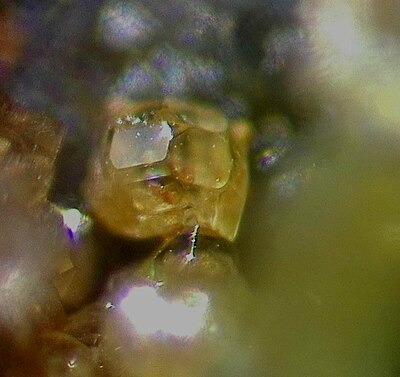Elpasolite
| Elpasolite | |
|---|---|
| Close-up of an elpasolite crystal from the Le Cetine di Cotorniano mine, Chiusdino , Tuscany, Italy (field of view 0.5 mm) | |
| General and classification | |
| chemical formula | K 2 [12] Na [6] [AlF 6 ] |
|
Mineral class (and possibly department) |
Halides |
|
System no. to Strunz and to Dana |
3.CB.15 ( 8th edition : III / B.03) 06/11/02/01 |
| Crystallographic Data | |
| Crystal system | cubic |
| Crystal class ; symbol | cubic hexakisoctahedral; 4 / m 3 2 / m |
| Space group | Fm 3 m (No. 225) |
| Lattice parameters | a = 8.12 Å |
| Formula units | Z = 4 |
| Frequent crystal faces | [111] |
| Physical Properties | |
| Mohs hardness | 2.5 |
| Density (g / cm 3 ) | measured: 2.98 (1); calculated: 3.01 |
| Cleavage | no |
| Break ; Tenacity | uneven |
| colour | colorless |
| Line color | White |
| transparency | transparent to translucent |
| shine | weak glass luster, fat luster |
| radioactivity | hardly measurable |
| Crystal optics | |
| Refractive index | n = 1.376 (2) |
| Other properties | |
| Special features | Occasional fluorescence |
Elpasolite is a very rarely occurring mineral from the mineral class of halides with the chemical composition K 2 [12] Na [6] [AlF 6 ]. From a chemical point of view, it is therefore a potassium - sodium - aluminofluoride .
Elpasolite crystallizes in the cubic crystal system and has so far only been discovered in the form of granular to massive mineral aggregates consisting of colorless and transparent to translucent crystals less than a millimeter in size. The habitus of these elpasolite crystals is mostly octahedral or trapezoidal and their surfaces have a weak glass- to fat-like sheen .
Etymology and history
Elpasolite was first discovered in quartz - Mikroklingängen Pikes Park Granite in El Paso County (Colorado) and described in 1883 by Cross and Hillebrand, the mineral after its type locality named.
classification
In the outdated, but partly still in use 8th edition of the mineral classification according to Strunz , the elpasolite belonged to the mineral class of "halides" and there to the division of "double halides with [BF 4 ] 1− , [SiF 6 ] 2− and [AlF 6 ] 3− ", where together with cryolite he created the" cryolite-elpasolite group "with system no. III / B.03 and the other members Bøgvadit , Calcjarlit , Colquiriit , Jarlit , Jørgensenit , Kryolithionit and Simmonsit .
In contrast , the 9th edition of Strunz's mineral systematics, which has been in force since 2001 and is used by the International Mineralogical Association (IMA), classifies elpasolite in the more general section of “Complex Halides”. This is, however, further subdivided according to the crystal structure, so that the mineral can be found according to its structure in the subsection "Island aluminofluoride (Neso-aluminofluoride)", where it is only together with cryolite and simmonsite the "cryolite group" with the system No. 3.CB.15 forms.
The systematics of minerals according to Dana , which is mainly used in the English-speaking world , assigns the elpasolite to the class of "halides" and there in the department of "complex halides - aluminum fluorides". Here he is the only member of the unnamed group 11.06.02 within the sub-section “ Complex halides - aluminum fluorides with different formulas ”.
Crystal structure
Elpasolite crystallizes cubically in the space group Fm 3 m (space group no. 225) with the lattice parameter a = 8.12 Å and four formula units per unit cell .
properties
Occasionally, elpasolite samples show a bluish fluorescence with a tinge of violet under UV light .
Education and Locations
Elpasolite forms secondary from fluorine-containing minerals in pegmatitic ducts.
In the type deposit Pikes Peak in Colorado (USA) it occurs together with cryolite , pachnolite , thomsenolite , prosopite and gearksutite . In the quartz veins of a hydrothermal antimony deposit in Italy (cetine mine), elpasolite is associated with ralstonite , rosenbergite , gypsum , fluorite and quartz.
Other well-known sites include the Ivittuut (Ivigtut) cryolite deposit in Greenland ; near Chiusdino in Tuscany (Italy); in the mountains of Kedykverpakhk and Koaschwa on the Kola Peninsula and in GI Gasberg's Topaz cryolite mine in the southern Urals (Russia); in Zhytomyr Oblast in Ukraine; as well as in the Goldie carbonatite in Fremont County, Colorado , in the Zapot pegmatite in Nevada and in the Morefield pegmatite in Virginia in the USA .
See also
literature
- Helmut Schrätze , Karl-Ludwig Weiner: Mineralogy. A textbook on a systematic basis . de Gruyter, Berlin; New York 1981, ISBN 3-11-006823-0 .
- Paul Ramdohr , Hugo Strunz : Klockmann's textbook of mineralogy . 16th edition. Ferdinand Enke Verlag, 1978, ISBN 3-432-82986-8 .
- W. Cross, WF Hillebrand : Mineralogy of the Rocky Mountains, II Minerals from the neighborhood of Pike's Peak. In: US Geological Survey Bulletin Volume 20 (1883), pp. 40-74
- Clifford Frondel : New Data on Elpasolite and Hagemannite. In: American Mineralogist. Volume 33, 1948, pp. 84–87 ( PDF 233 kB )
Web links
Individual evidence
- ↑ a b c d Hugo Strunz , Ernest H. Nickel : Strunz Mineralogical Tables. Chemical-structural Mineral Classification System . 9th edition. E. Schweizerbart'sche Verlagbuchhandlung (Nägele and Obermiller), Stuttgart 2001, ISBN 3-510-65188-X , p. 161 .
- ↑ a b Webmineral - Elpasolite (English)
- ↑ a b Elpasolite , In: John W. Anthony, Richard A. Bideaux, Kenneth W. Bladh, Monte C. Nichols (Eds.): Handbook of Mineralogy, Mineralogical Society of America , 2001 ( PDF 68.5 kB )
- ↑ Mindat - Elpasolite (English)
- ↑ Find location list for elpasolite in the Mineralienatlas and Mindat


